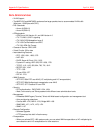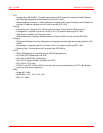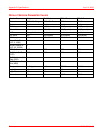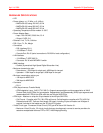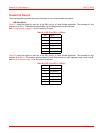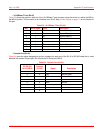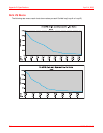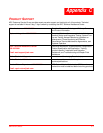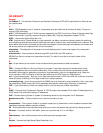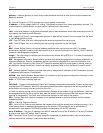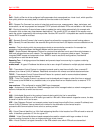
April 14, 2006 Glossary
MM70xG2-UM-03 GL-3
Q
QoS – Quality of Service is the configured traffic parameters that are assigned to a virtual circuit, which specifies
how quickly and how accurately data is transferred from the sender to the receiver.
R
RFC – Request For Comment is a series of notes that contain surveys, measurements, ideas, techniques, and
observations, as well as proposed and accepted TCP/IP protocol standards. RFCs are available on the Internet.
RIP – Routing Information Protocol allows routers to update the routing tables automatically (for example with
information such as how many hops between destinations). The version of RIP you select for the session must
match the version supported by the service provider. Versions RIP1 and RIP-1 compatible are used for broadcast.
Version RIP 2 is used for multicast.
S
SEF – Severely Errored Frames is the incoming signal has at least four consecutive errored framing patterns.
SES – Severely Errored Seconds is the seconds during which more than 2,500 bipolar errors are detected on the
line.
session – The time during which two computers maintain a communication connection. An example is a
connection configured between the Megabit Modem and the service provider.
SNMP – Simple Network Management Protocol is a protocol that specifies how to send information between a
NMS and managed devices on a network. The managed devices run a program called an agent. The agent
interprets SNMP request and responds to them. SNMP is used to set device configurations, read device
configurations or read the device status.
Spanning Tree – A bridging protocol that detects and prevents loops from occurring in a system containing
multiple bridges.
subnet mask – A type of IP address that allows a site to use a single IP address for multiple physical networks.
T
TCP – Transmission Control Protocol is a transport protocol used to map inbound traffic (from a remote IP
address) to an internal (LAN) IP address. Establishes connection with remote user before data transmission.
TCP/IP – Transmission Control Protocol/Internet Protocol is a protocol used for communications between
computers over networks and the internet.
TFTP – Trivial File Transfer Protocol is a protocol used to download card images or other files from an external
TFTP server to the NVRAM of any installed cards, or to upload files from an installed card to an external TFTP
server.
trap receivers – PCs configured to receive SNMP traps (messages).
traps – Autonomous, interrupt-driven, SNMP messages sent from a managed node to a network management
station to indicate that an event has occurred.
U
UAS – UnAvailable Seconds is the number of seconds during which the line is unavailable.
UBR – Unspecified Bit Rate is an ATM traffic type used for LAN traffic. When network congestion occurs, the data
is stored in a buffer until it can be sent.
UDP – User Datagram Protocol is a transport protocol used to map inbound traffic (from a remote IP address) to an
internal (LAN) IP address. Uses a protocol port number for the destination at the remote location.
upstream trafficCommunications from a user to a service provider.
V
VCI – Virtual Channel Identifier is a 16-bit field addressing identifier in the header of an ATM cell used to route cell
traffic. It identifies a particular VC link for a given VP.
VCMUX – Virtual Channel Multiplexer-based encapsulation used for networks with large numbers of virtual
channels making it practical to carry a single protocol per virtual channel.
VCA – Virtual Channel is a logical connection in the ATM network over which ATM cells are transmitted.




